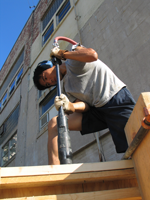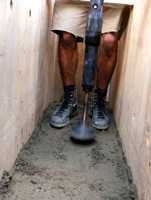





Compaction
In order to gain an understanding of the factors influencing proper compaction, we placed and compacted the first side of the wall by hand. This approach permitted comparison of the efficiencies of hand- versus-mechanical placement and compaction. The first half of the wall was thus placed with five-gallon-buckets in an assembly-line fashion, and compacted with hand tampers, a tool made from a steel plate mounted at the end of a wooden handle. The soil is placed in the formwork in layers eight inches deep, which are compacted to approximately five inches. This phase of the project taught us a great deal about managing material flow, the feeling of solid compaction, and the value of perseverance.
The second half of the wall was placed and compacted mechanically and went considerably faster, construction taking approximately one quarter of the time of the first half. Some of this gain in time can be attributed to our increase in understanding of the task at hand, but the use of a hydraulic loader to place the soil and a pneumatic backfill tamper to compact undoubtedly resulted in considerable savings in labor. It should be noted that some of this savings must be applied toward the environmental and economic cost of running and maintaining the various machines, but it would seem that this approach would make the most sense in a region such as New England, where labor cost is relatively high. Indeed, every contemporary rammed earth project site visited during the first stage of the research utilized mechanical methods of placement and compaction.